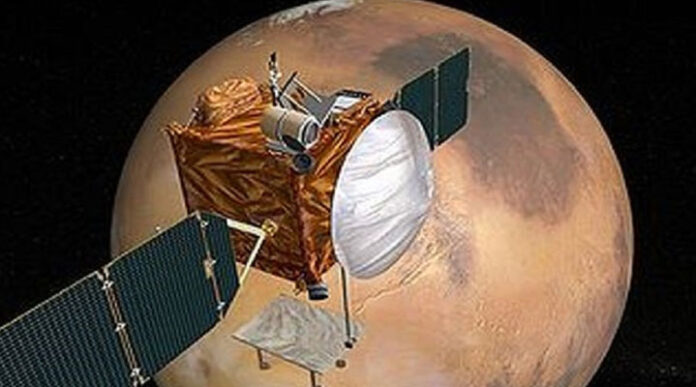On September 24, 2014, ISRO’s Mars Orbiter Mission was successfully inserted into Martian orbit after being launched on PSLV-C25 in November 2013.
It has been suggested that India’s first interplanetary mission, “Mangalyaan,” may have finally ended its long run after its Mars Orbiter craft ran out of propellant and its battery discharged past the safe limit.
The PSLV-C25 rocket carrying the Rs. 450 crore Mars Orbiter Mission lifted off on November 5, 2013, and on September 24, 2014, the MOM spacecraft successfully inserted itself into Martian orbit.
“There is currently no fuel available. The satellite’s battery is empty “PTI was informed by sources at the Indian Space Research Organization. “The connection is broken.”
In the past, ISRO had been performing orbital maneuvers on the MOM spacecraft with fuel on board to move it to a new orbit to avoid an approaching eclipse.
On condition of anonymity, officials stated: “But recently there were back-to-back eclipses, including one that lasted seven and a half hours.” They added that all the propellant on board the aging satellite had been used.
“A longer eclipse would drain the battery beyond the safe limit,” another official said. “The satellite battery is designed to handle eclipse duration of only about one hour and 40 minutes.”
According to ISRO officials, the Mars orbiter craft operated well past its intended mission life of six months, lasting almost eight years.
They claimed that it had accomplished its task and produced important scientific findings. The mission’s primary technological goals included designing, creating, and launching a Mars Orbiter spacecraft that could orbit Mars with enough autonomy during the journey phase, orbit insertion and capture, and in-orbit phase.
The MOM, a technology demonstration project, carried five scientific payloads weighing a combined 15 kg, gathering information on surface geology, morphology, atmospheric processes, surface temperature, and atmospheric escape process.
The five instruments are the Lyman Alpha Photometer, Mars Color Camera (MCC), Mars Exospheric Neutral Composition Analyzer (MENCA), Thermal Infrared Imaging Spectrometer (TIS), and Methane Sensor for Mars (MSM) (LAP).
According to ISRO officials, “MOM is credited with many laurels, including cost-effectiveness, short time to realization, economical mass-budget, and miniaturization of five heterogeneous science payloads.”
Due to MOM’s highly elliptical orbit geometry, MCC was able to capture images of Mars’ “Full disc” at its furthest point and more minute details at its closest point.
The MCC has released a Mars Atlas and created more than 1000 images.
Plans for a subsequent Mangalyaan mission to the red planet, however, have not yet been finalized.
In 2016, ISRO released an “Announcement of Opportunity” (AO) for the future Mars Orbiter Mission (MOM-2), but officials acknowledged that it is still in the planning stages as the space agency is currently prioritizing the “Gaganyaan,” “Chandrayaan-3,” and “Aditya – L1” projects.
The AO had stated, “The next orbiter mission will now be around Mars for a potential future launch opportunity. We are looking for proposals from interested Indian scientists for experiments that will be carried out during the MOM-2 mission, which will orbit Mars. When asked for an update on the MOM-2, a senior ISRO official responded, “Not in the approved list as of now.”
The official stated, “We need to develop the project proposals and payloads based on the broad consultation with the research community. “It’s still in the conceptual stage. But for the mission to be completed, more information and international cooperation are required.”





